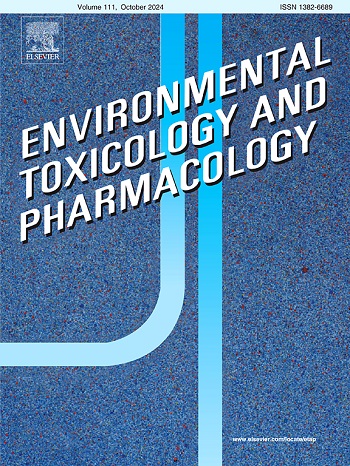在单一和二元暴露情景下,吡虫啉和克百威在胎生鳗体内的生物累积、转化和毒性。
IF 4.2
3区 环境科学与生态学
Q2 ENVIRONMENTAL SCIENCES
引用次数: 0
摘要
将蚯蚓(Eisenia fetida)暴露于0.05和0.5毫克/千克的吡虫啉(IMI)和双呋喃丹(DIN)的单独和二元混合物中28天,以研究它们的生物累积、转化和毒性。与 DIN 相比,IMI 更容易被蚯蚓吸收,而且蚯蚓不会积累或产生有毒代谢物。新烟碱类物质在后期的明显积累会导致明显的神经功能紊乱,尤其是在接触高浓度 IMI 的情况下。同时,二元暴露于高浓度 IMI 会诱发氧化应激,表现为 SOD/CAT 活性降低(33.2%-68.1%)和 MDA 增加(38.4%-55.0%)。相比之下,腔肠细胞的反应比氧化反应更早、更强烈。腹腔细胞的活力和线粒体膜电位主要受到 IMI 和二元暴露的抑制(23.6%-91.7%)。腹腔细胞的乳酸脱氢酶活性呈波动模式,表明细胞功能受到不规则干扰。这项研究强调了腔肠细胞的作用,以及在评估新烟碱类化合物对蚯蚓的风险时考虑二元/多元情景和转化的必要性。本文章由计算机程序翻译,如有差异,请以英文原文为准。
Bioaccumulation, transformation and toxicity of imidacloprid and dinotefuran in Eisenia fetida under single and binary exposure scenarios
Earthworms (Eisenia fetida) were exposed to individual and binary mixture of imidacloprid (IMI) and dinotefuran (DIN) at 0.05 and 0.5 mg/kg for 28 days to investigate their bioaccumulation, transformation and toxicity. IMI was more easily absorbed by earthworms than DIN, and worms didn’t accumulate or generate toxic metabolites. The obvious accumulation of neonicotinoids during later period caused significant neural dysfunction, especially when exposed to high-concentration IMI. Meanwhile, oxidative stress indicated by decreased SOD/CAT activity (33.2 %-68.1 %) and increased MDA (38.4 %-55.0 %) was induced by binary exposure with high-concentration IMI. By contrast, coelomocytes responded earlier and more strongly than oxidative responses. Coelomocytes’ viability and mitochondrial membrane potential were inhibited (23.6 %-91.7 %) mainly by IMI and binary exposure. Coelomocytes’ lactate dehydrogenase activity exerted a fluctuating pattern, suggesting irregular disturbance on cellular functions. This study highlights the role of coelomocytes and the need to consider binary/multiple scenarios and transformation of neonicotinoids in their risk assessment to earthworms.
求助全文
通过发布文献求助,成功后即可免费获取论文全文。
去求助
来源期刊
CiteScore
7.00
自引率
4.70%
发文量
185
审稿时长
34 days
期刊介绍:
Environmental Toxicology and Pharmacology publishes the results of studies concerning toxic and pharmacological effects of (human and veterinary) drugs and of environmental contaminants in animals and man.
Areas of special interest are: molecular mechanisms of toxicity, biotransformation and toxicokinetics (including toxicokinetic modelling), molecular, biochemical and physiological mechanisms explaining differences in sensitivity between species and individuals, the characterisation of pathophysiological models and mechanisms involved in the development of effects and the identification of biological markers that can be used to study exposure and effects in man and animals.
In addition to full length papers, short communications, full-length reviews and mini-reviews, Environmental Toxicology and Pharmacology will publish in depth assessments of special problem areas. The latter publications may exceed the length of a full length paper three to fourfold. A basic requirement is that the assessments are made under the auspices of international groups of leading experts in the fields concerned. The information examined may either consist of data that were already published, or of new data that were obtained within the framework of collaborative research programmes. Provision is also made for the acceptance of minireviews on (classes of) compounds, toxicities or mechanisms, debating recent advances in rapidly developing fields that fall within the scope of the journal.

 求助内容:
求助内容: 应助结果提醒方式:
应助结果提醒方式:


